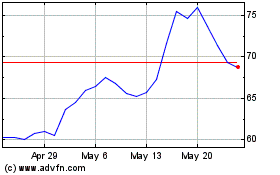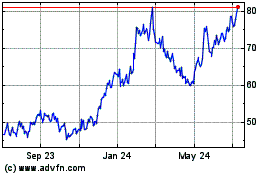Vaxcyte, Inc. (Nasdaq: PCVX), a clinical-stage vaccine innovation
company engineering high-fidelity vaccines to protect humankind
from the consequences of bacterial diseases, today announced the
initiation of the Phase 2 study of VAX-31 in healthy infants and
that the first study participants have been dosed. This study is
evaluating the safety, tolerability and immunogenicity of VAX-31, a
31-valent pneumococcal conjugate vaccine (PCV) candidate designed
to prevent invasive pneumococcal disease (IPD). The Company expects
to share topline data from the primary three-dose immunization
series of the study in mid-2026, followed by topline data from the
booster dose approximately nine months later.
“The initiation of the VAX-31 Phase 2 infant study
marks a significant milestone as we continue advancing our PCV
clinical programs, which also include the fully enrolled, ongoing
VAX-24 Phase 2 infant study,” said Grant Pickering, Chief Executive
Officer and Co-founder of Vaxcyte. “PCVs are vital to combating
Streptococcus pneumoniae, a serious public health threat
exacerbated by increasing antimicrobial resistance. As the
broadest-spectrum PCV candidate in the clinic today, VAX-31 has the
potential to expand coverage and provide protection against both
currently circulating and historically prevalent serotypes. We look
forward to sharing topline data for safety, tolerability and
immunogenicity from the VAX-31 Phase 2 infant study’s primary
immunization series in mid-2026, and from the booster dose
approximately nine months later.”
“Despite the effectiveness of current vaccines,
Streptococcus pneumoniae is the leading cause of
vaccine-preventable deaths globally in children under five and IPD,
including meningitis and bacteremia, remains persistent in the
first years of life,” said Jim Wassil, Executive Vice President and
Chief Operating Officer of Vaxcyte. “It has been clearly signaled
by the public health community that a pneumococcal vaccine with a
broader spectrum of coverage is needed to provide greater
protection against this disease. VAX-31 is designed to cover
approximately 94% of IPD and approximately 93% of acute otitis
media in U.S. children under five, with the potential to offer much
greater coverage relative to the standard-of-care PCVs.”
About the VAX-31 Phase 2 Infant
StudyThe VAX-31 Phase 2 infant study is a randomized,
double-blind, active controlled, dose-finding, two-stage clinical
study evaluating the safety, tolerability and immunogenicity of
VAX-31 compared to Prevnar 20 (PCV20) in healthy infants.
- Stage 1 of the study is evaluating the safety and tolerability
of VAX-31 at three dose levels (low, middle and high) and compared
to PCV20 in approximately 48 infants in a dose-escalation approach.
In the low, middle and high doses, all serotypes were dosed at
1.1mcg, 2.2mcg and 3.3mcg, respectively, except serotypes 1, 5 and
22F, which were dosed at 1.65mcg, 3.3mcg, and 4.4mcg, respectively.
Participants who receive VAX-31 in Stage 1 will continue the
standard dosing regimen as part of Stage 2 and will be included in
the safety, tolerability and immunogenicity analysis of the
study.
- Stage 2 of the study will evaluate the safety, tolerability and
immunogenicity of VAX-31 at the same three dose levels and compared
to PCV20 in approximately 750 infants.
- In line with recommendations from the Advisory Committee on
Immunization Practices (ACIP), the study design includes a primary
immunization series consisting of three doses given at two months,
four months and six months of age, followed by a subsequent booster
dose at 12-15 months of age.
- The key prespecified immunogenicity study endpoints include an
assessment of immune responses for each of the VAX-31 dose levels
in comparison with PCV20 for the 20 common and 11 unique serotypes
in VAX-31. Post-primary series (post-dose 3 or PD3) immune
responses will be assessed based on serotype-specific
immunoglobulin G (IgG) seroresponse rates (proportion of
participants achieving the accepted IgG threshold value of
≥0.35mcg/mL) at 30 days PD3. IgG geometric mean titers will be
assessed at 30 days PD3 and post-dose 4 (PD4), along with other key
immunogenicity endpoints.
- All participants in the study will be evaluated for safety
through six months following the booster dose.
- The study is being conducted at approximately 50 sites in the
United States.
About Pneumococcal
DiseasePneumococcal disease (PD) is an infection caused
by Streptococcus pneumoniae bacteria. It can result in
invasive pneumococcal disease (IPD), including meningitis and
bacteremia, and non-invasive PD, including pneumonia, otitis media
and sinusitis. In the United States, pneumococcal pneumonia is
estimated to result in approximately 150,000 hospitalizations each
year. Streptococcus pneumoniae is among the World Health
Organization’s top antibiotic-resistant pathogens to be urgently
addressed, and the U.S. CDC lists drug-resistant Streptococcus
pneumoniae as a “serious threat.” In children under five,
Streptococcus pneumoniae is the leading cause of
vaccine-preventable deaths globally. Pneumococci also cause over
50% of all cases of bacterial meningitis in the United States.
Antibiotics are used to treat PD, but some strains of the bacteria
have developed resistance to treatments. The morbidity and
mortality due to PD are significant, particularly for young
children and older adults, underscoring the need for a
broader-spectrum vaccine.
About VAX-31VAX-31, a 31-valent
PCV candidate advancing to a Phase 3 adult clinical program and
currently being evaluated in a Phase 2 infant clinical program, is
designed to prevent IPD, which is especially serious in infants,
young children, older adults and those with immune deficiencies or
certain chronic health conditions. IPD is associated with high
case-fatality rates, antibiotic resistance and meningitis. VAX-31
is the broadest-spectrum PCV in the clinic and has the potential to
provide protection against both currently circulating and
historically prevalent serotypes. VAX-31 was designed to increase
coverage, in a single vaccine, to more than 95% of IPD circulating
in adults in the United States aged 50 and older, with the
potential to provide an incremental 12-40% of coverage over current
standard-of-care adult PCVs. In infants, it was designed to cover
approximately 94% of IPD and approximately 93% of acute otitis
media due to Streptococcus pneumoniae in children under five years
of age in the United States.
In November 2024, Vaxcyte announced that the FDA
granted Breakthrough Therapy designation to VAX-31 for the
prevention of IPD in adults. The Breakthrough Therapy designation
process is designed to expedite the development and review of drugs
that are intended to treat a serious or life-threatening
condition.
About Vaxcyte Vaxcyte is a vaccine
innovation company engineering high-fidelity vaccines to protect
humankind from the consequences of bacterial diseases. The Company
is developing broad-spectrum conjugate and novel protein vaccines
to prevent or treat bacterial infectious diseases. VAX-31 is a
31-valent, carrier-sparing PCV being developed for the prevention
of IPD in adults and infants and is the broadest-spectrum PCV
candidate in the clinic today. VAX-24, the Company’s 24-valent PCV
candidate, is designed to cover more serotypes than any infant PCV
on-market and is currently being evaluated in a Phase 2 infant
study. Both VAX-31 and VAX-24 are designed to improve upon the
standard-of-care PCVs by covering the serotypes in circulation that
are responsible for a significant portion of IPD and are associated
with high case-fatality rates, antibiotic resistance and
meningitis, while maintaining coverage of previously circulating
strains that are currently contained through continued vaccination
practice.
Vaxcyte is re-engineering the way highly complex
vaccines are made through modern synthetic techniques, including
advanced chemistry and the XpressCF™ cell-free protein synthesis
platform, exclusively licensed from Sutro Biopharma, Inc. Unlike
conventional cell-based approaches, the Company’s system for
producing difficult-to-make proteins and antigens is intended to
accelerate its ability to efficiently create and deliver
high-fidelity vaccines with enhanced immunological benefits.
Vaxcyte’s pipeline also includes VAX-A1, a prophylactic vaccine
candidate designed to prevent Group A Strep infections; VAX-PG, a
therapeutic vaccine candidate designed to slow or stop the
progression of periodontal disease; and VAX-GI, a vaccine candidate
designed to prevent Shigella. Vaxcyte is driven to eradicate or
treat invasive bacterial infections, which have serious and costly
health consequences when left unchecked. For more information,
visit www.vaxcyte.com.
Forward-Looking Statements This
press release contains forward-looking statements within the
meaning of The Private Securities Litigation Reform Act of 1995.
These statements include, but are not limited to, statements
related to the potential benefits of VAX-24 and VAX-31, including
breadth of coverage, and the ability to deliver potentially
best-in-class PCVs and improve upon the standard-of-care a; the
process and timing of anticipated future development of Vaxcyte’s
vaccine candidates; the design of the VAX-31 infant Phase 2 study,
and the timing of its data readouts; the demand for Vaxcyte’s
vaccine candidates; and other statements that are not historical
fact. The words “anticipate,” “believe,” “could,” “expect,”
“intend,” “may,” “on track,” “potential,” “should,” “would” and
similar expressions (as well as other words or expressions
referencing future events, conditions or circumstances) convey
uncertainty of future events or outcomes and are intended to
identify forward-looking statements, although not all
forward-looking statements contain these identifying words. These
forward-looking statements are based on Vaxcyte’s current
expectations and actual results and timing of events could differ
materially from those anticipated in such forward-looking
statements as a result of risks and uncertainties, including,
without limitation, risks related to Vaxcyte’s product development
programs, including development timelines, success and timing of
chemistry, manufacturing and controls and related manufacturing
activities, potential delays or inability to obtain and maintain
required regulatory approvals for its vaccine candidates, and the
risks and uncertainties inherent with preclinical and clinical
development processes; the success, cost and timing of all
development activities and clinical trials; and sufficiency of cash
and other funding to support Vaxcyte’s development programs and
other operating expenses. These and other risks are described more
fully in Vaxcyte’s filings with the Securities and Exchange
Commission (SEC), including its Quarterly Report on Form 10-Q filed
with the SEC on November 5, 2024 or in other documents Vaxcyte
subsequently files with or furnishes to the SEC. All
forward-looking statements contained in this press release speak
only as of the date on which they were made and are based on
management’s assumptions and estimates as of such date, and readers
should not rely upon the information in this press release as
current or accurate after its publication date. Vaxcyte undertakes
no duty or obligation to update any forward-looking statements
contained in this release as a result of new information, future
events or changes in its expectations. Readers should not rely upon
the information in this press release as current or accurate after
its publication date.
Contacts:Patrick Ryan, Executive
Director, Corporate CommunicationsVaxcyte,
Inc.415-606-5135media@vaxcyte.com
Jennifer Zibuda, Senior Director, Investor
RelationsVaxcyte, Inc.860-729-8902investors@vaxcyte.com
Vaxcyte (NASDAQ:PCVX)
Historical Stock Chart
From Dec 2024 to Jan 2025

Vaxcyte (NASDAQ:PCVX)
Historical Stock Chart
From Jan 2024 to Jan 2025
